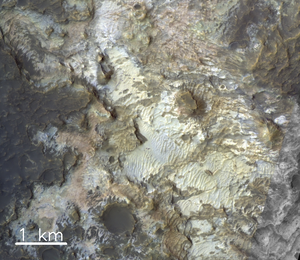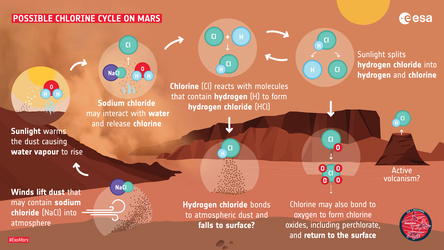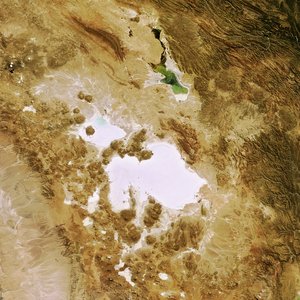

Mermaid on salty Mars
A purplish, scaley wave lures the attention of a European spacecraft as it flies over Mars's Terra Sirenum, Latin for Sea of the Sirens.
It is just an optical illusion – there are no mythological mermaids or seas on the martian world today. Mars is currently a desert world that used to be covered by rivers, lakes, and possibly oceans some 3.5 billion years ago. A cold era began when Mars lost its magnetic field and could no longer hold its own atmosphere, leading to water evaporating, freezing, or becoming trapped within the surface.
As the water disappeared over time, it left mineral fingerprints on the surface. One such footprint is this purple-coloured stamp ESA's ExoMars Trace Gas Orbiter (TGO) detected in this colour-infrared image of a dried-up riverbed in the southern hemisphere of the Red Planet.
The European orbiter used its Colour and Stereo Surface Imaging System (CaSSIS) to reveal chloride salt deposits in the cratered region of Terra Sirenum. Most likely, those salt deposits formed from shallow ponds of water or brine that evaporated in the Sun. People use a similar method to produce salt for human consumption in saltwater pools on Earth.
Very salty waters could have become a haven for life, a beacon for habitable places on Mars. High concentrations of salt allow water to remain liquid at temperatures as low as –40 ºC. The chloride deposits in this picture and its direct relation to liquid water make areas such as Terra Sirenum good targets for future robotic missions searching for signs of life.
Chloride-bearing terrain does not stand out in regular black-and-white images but shows up as a distinct purple hue in colour-infrared images, making CaSSIS a unique tool to study the distribution of salts across Mars.
Last week this research was published in Nature’s Scientific Data journal. The new paper includes never-seen-before data that helps us better understand the distribution of water in Mars's distant past.
TGO continues to image Mars from orbit to understand its ancient past and potential habitability. The spacecraft is not only returning spectacular images, but also providing the best inventory of atmospheric gases and mapping the planet’s surface for water-rich locations.
Understanding the history of water on Mars and whether it once allowed life to flourish is at the heart of ESA’s ExoMars missions.
TGO captured this image on 20 August 2022, centred at 205.2°E, 32.9°S in Terra Sirenum. The full CaSSIS image is available here with file name MY36_021144_325_0.





